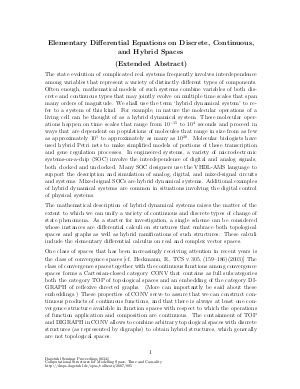Elementary Differential Calculus on Discrete, Continuous and Hybrid Spaces
Author Howard Blair
-
Part of:
Volume:
Dagstuhl Seminar Proceedings, Volume 6341
Part of: Series: Dagstuhl Seminar Proceedings (DagSemProc) - License:
 Creative Commons Attribution 4.0 International license
Creative Commons Attribution 4.0 International license
- Publication Date: 2007-02-26
File

PDF
DagSemProc.06341.4.pdf
- Filesize: 66 kB
- 2 pages
Document Identifiers
Subject Classification
Keywords
- Hybrid space
- convergence space
- differential
- calculus
- chain rule
- hybrid dynamical system
- discrete structure
- topological space
Metrics
- Access Statistics
-
Total Accesses (updated on a weekly basis)
0Document
0Metadata
Abstract
We unify a variety of continuous and discrete types of change of state phenomena using a scheme whose instances are differential calculi on structures that embrace both topological spaces and graphs as well as hybrid ramifications of such structures. These calculi include the elementary differential calculus on real and complex vector spaces. One class of spaces that has been increasingly receiving attention in recent years is the class of convergence spaces [cf. Heckmann, R., TCS v.305, (159--186)(2003)]. The class of convergence spaces together with the continuous functions among convergence spaces forms a Cartesian-closed category CONV that contains as full subcategories both the category TOP of topological spaces and an embedding of the category DIGRAPH of reflexive directed graphs. (More can importantly be said about these embeddings.) These properties of CONV serve to assure that we can construct continuous products of continuous functions, and that there is always at least one convergence structure available in function spaces with respect to which the operations of function application and composition are continuous. The containment of TOP and DIGRAPH in CONV allows to combine arbitrary topological spaces with discrete structures (as represented by digraphs) to obtain hybrid structures, which generally are not topological spaces. We give a differential calculus scheme in CONV that addresses three issues in particular. 1. For convergence spaces $X$ and $Y$ and function $f: X longrightarrow Y$, the scheme gives necessary and sufficient conditions for a candidate differential $df: X longrightarrow Y$ to be a (not necessarily "the", depending on the spaces involved) differential of $f$ at $x_0$. 2. The chain rule holds and the differential relation between functions distributes over Cartesian products: e.g. if $Df$, $Dg$ and $Dh$ are, respectively, differentials of $f$ at $(g(x_0),h(x_0))$ and $g$ and $h$ at $x_0$, then $Df circ (Dg times Dh)$ is a differential of $f circ (g times h)$ at $x_0$. 3. When specialized to real and complex vector spaces, the scheme is in agreement with ordinary elementary differential calculus on these spaces. Moreover, with two additional constraints having to do with self-differentiation of differentials and translation invariance (for example, a linear operator on, say, $C^2$, is its own differential everywhere) there is a (unique) maximum differential calculus in CONV.
Cite As Get BibTex
Howard Blair. Elementary Differential Calculus on Discrete, Continuous and Hybrid Spaces. In Computational Structures for Modelling Space, Time and Causality. Dagstuhl Seminar Proceedings, Volume 6341, pp. 1-2, Schloss Dagstuhl – Leibniz-Zentrum für Informatik (2007)
https://doi.org/10.4230/DagSemProc.06341.4
BibTex
@InProceedings{blair:DagSemProc.06341.4,
author = {Blair, Howard},
title = {{Elementary Differential Calculus on Discrete, Continuous and Hybrid Spaces}},
booktitle = {Computational Structures for Modelling Space, Time and Causality},
pages = {1--2},
series = {Dagstuhl Seminar Proceedings (DagSemProc)},
ISSN = {1862-4405},
year = {2007},
volume = {6341},
editor = {Ralph Kopperman and Prakash Panangaden and Michael B. Smyth and Dieter Spreen},
publisher = {Schloss Dagstuhl -- Leibniz-Zentrum f{\"u}r Informatik},
address = {Dagstuhl, Germany},
URL = {https://drops.dagstuhl.de/entities/document/10.4230/DagSemProc.06341.4},
URN = {urn:nbn:de:0030-drops-8956},
doi = {10.4230/DagSemProc.06341.4},
annote = {Keywords: Hybrid space, convergence space, differential, calculus, chain rule, hybrid dynamical system, discrete structure, topological space}
}
